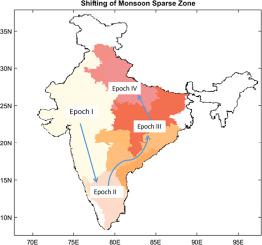Atmospheric Research ( IF 5.5 ) Pub Date : 2021-08-08 , DOI: 10.1016/j.atmosres.2021.105806 Vasundhara Barde 1 , P. Sinha 1 , U.C. Mohanty 1 , Xiang Zhang 2 , Dev Niyogi 3

|
The Indian southwest monsoon season is considered the lifeline of the region's socioeconomic wellbeing. It is recognized that even small variations often lead to notable impacts on the regional economy and agricultural productivity. As a precursor to droughts, this study identifies from century-long data, Monsoon Sparse Zone (MSZ) as a locale with less seasonal rainfall compared to the long-term average climatology. Identifying the MSZ is crucial to understand the spread and propagation of drought-prone areas. The present study investigates the nature of the major MSZ shift in India during the past 116 years (1901–2016) and probable meteorological factors responsible for that transitions. For this purpose, the high-resolution daily rainfall analysis from India Meteorological Department (IMD) and other surface and upper air meteorological parameters from, the NOAA, CRU, and NCEP-NCAR are used. Two drought indices are used to study the MSZ and its epochal shifts during the past century over India. The MSZ locales follow the counter-clockwise shift from west to north-central India through the peninsular region from one to another epoch (each of 29 years) that is statistically significant. The MSZ shifting is insensitive to epochal duration selection. Large-scale and regional processes that may impact the shift of MSZ are analyzed. The El Niño-Southern Oscillation (ENSO) and Indian Ocean Dipole (IOD) have strong influences on the MSZ shift. Additional synergistic effect of large-scale – factors such as westward shifting of subsidence branch of the Walker circulation, the orientation of IOD and local-scale phenomena like the increased surface temperature, moisture flux inflow from the Bay of Bengal, also have shifts aligning to cause this detectable and significant change in the MSZ locales. The presence of MSZ conforms to the drought-prone area over India and has a direct influence on water resources, agriculture, and allied sectors.
中文翻译:

印度季风稀疏区的逆时针划时代变化
印度西南季风季节被认为是该地区社会经济福祉的生命线。人们认识到,即使是很小的变化也往往会对区域经济和农业生产力产生显着影响。作为干旱的前兆,本研究从长达一个世纪的数据中确定,与长期平均气候相比,季风稀疏区 (MSZ) 是季节性降雨量较少的地区。识别 MSZ 对于了解干旱易发地区的蔓延和传播至关重要。本研究调查了过去 116 年(1901-2016 年)印度主要 MSZ 转变的性质以及可能导致这种转变的气象因素。为此,使用来自印度气象局 (IMD) 的高分辨率日降雨量分析以及来自 NOAA、CRU 和 NCEP-NCAR 的其他地面和高空气象参数。使用两个干旱指数来研究过去一个世纪印度的 MSZ 及其划时代的变化。MSZ 区域遵循从印度西部到中北部通过半岛地区从一个时代到另一个时代(每 29 年)的逆时针移动,具有统计学意义。MSZ 移动对纪元持续时间选择不敏感。分析了可能影响 MSZ 移动的大规模和区域过程。厄尔尼诺-南方涛动 (ENSO) 和印度洋偶极子 (IOD) 对 MSZ 偏移有很大影响。大尺度的额外协同效应——诸如沃克环流下沉分支向西移动、IOD 的方向和局部尺度现象(如地表温度升高、从孟加拉湾流入的水分通量)等因素也发生了变化。导致 MSZ 语言环境发生这种可检测的重大变化。MSZ 的存在符合印度的干旱多发区,对水资源、农业和相关部门有直接影响。


























 京公网安备 11010802027423号
京公网安备 11010802027423号